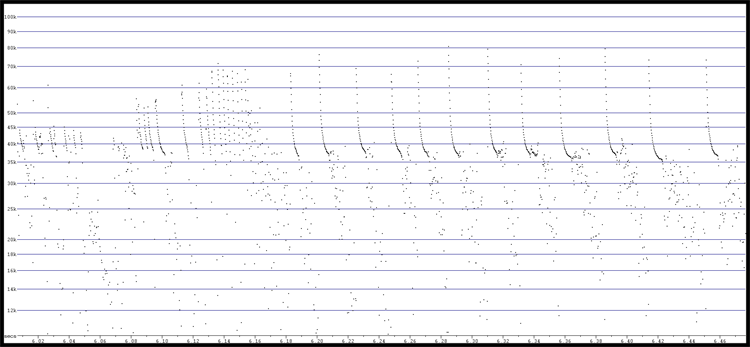Vespertilionidae
Guide for Acoustic Identification of Florida bats
Nychum or Nyhu
See glossary for explanation of codes
Nycticeius humeralis (Rafinesque, 1818)
Taxonomy follows Simmons and Cirranello (2021)
To view call graphics click on the camera icon on the right. You can then move through all images by using the left or right arrow keys. A left mouse click returns to the fact sheet.
Typical North American Vespertilionid pulses with FM reversed J broadband pulses of short duration.
See Garner et al., 2003.
| Parameters | N | Min | Max | Mean | St.Dev | 10% | 25% | 75% | 90% |
| Dur | 3115 | 0.1 | 14.0 | 5.7 | 3.67 | 0.32 | 1.98 | 8.71 | 10.11 |
| TBC | 3047 | 0.3 | 6574.8 | 157.1 | 262.1 | 7.0 | 87.5 | 172.7 | 268.8 |
| Fmin | 3115 | 23.7 | 41.5 | 36.0 | 2.1 | 33.5 | 34.6 | 37.6 | 38.7 |
| Fmax | 3115 | 40.0 | 85.1 | 49.2 | 8.7 | 40.4 | 41.5 | 54.4 | 62.5 |
| BW | 3115 | 0.1 | 49.3 | 13.1 | 9.8 | 2.2 | 5.0 | 19.2 | 27.7 |
| Fmean | 3115 | 36.0 | 43.0 | 39.1 | 1.6 | 37.0 | 38.0 | 40.2 | 41.4 |
| Fk | 3115 | 35.1 | 42.0 | 38.7 | 1.7 | 36.4 | 37.4 | 40.2 | 41.0 |
| FcH1 | 3115 | 16.1 | 20.0 | 18.6 | 0.7 | 17.6 | 18.0 | 19.2 | 19.6 |
| Fc | 3115 | 32.3 | 40.0 | 37.2 | 1.5 | 35.2 | 36.0 | 38.4 | 39.2 |
| FcH3 | 3115 | 48.4 | 60.0 | 55.8 | 2.2 | 52.9 | 54.1 | 57.6 | 58.8 |
| Sc | 3115 | -454.3 | 1458.6 | 78.6 | 157.1 | 3.8 | 12.6 | 57.5 | 249.8 |
| Pmc | 3115 | 0.0 | 129.5 | 32.6 | 25.4 | 4.5 | 10.7 | 48.6 | 70.3 |
Reported by Szewczak (2018)
| Nychum | Fc | Fmax | Fmin | FmaxE | dur | uppr slp | lwr slp | slp @ Fc | total slp |
| Mean | 37.8 | 63.0 | 36.1 | 40.0 | 6.6 | 12.5 | 2.3 | 1.2 | 4.9 |
| Max | 40.0 | 78.0 | 38.0 | 43.0 | 9.4 | 20.0 | 3.7 | 2.5 | 7.9 |
| Min | 36.0 | 48.0 | 34.0 | 37.0 | 3.8 | 4.7 | 0.9 | 0.0 | 1.8 |
Cynthia and George Marks
Reference calls recorded by Marks are being archived at BioAcoustica and will be freely available. See Baker et al., (2015).
|
|
Least concern; Ver.3.1 ; Population trend - stable; evaluated 2008. (I.U.C.N. 2017.)
The subspecies Nycticeius humeralis subtropicalis (Schwartz, 1951) described from southern Florida has not been found to differ from the nominate species (Simmons and Cirranello, 2020).
See Watkins (1972) for additional details on this species.
See Baker et. al., (2015) for discussion of BioAcoustica and Baker and Vincent (2019) for a critique of the lack of freely available acoustic data.
Baker, E., B. W. Price, S. D. Rycroft, J. Hill, and V. S. Smith. 2015. BioAcoustica: a free and open repository and analysis platform for bioacoustics. Database. 2015. bav054
Baker, E., and S. Vincent. 2019. A deafening silence: a lack of data and reproducibility in published bioacoustics research? Biodiversity Data Journal 7: e36783.
Garner, S. M., C. D. Hein, A. C. Miles, and S. S. Castleberry. 2003. Echolocation call parameters of Nycticeius humeralis. Bat Research News. 44: 140.
Marks, C. S., and G. E. Marks. 2006. Bats of Florida. Pp. 176. University of Florida Press, Gainesville.
Schwartz, A. 1951. A new race of bat (Nycticeius humeralis) from southern Florida. Journal of Mammalogy. 32:233-234.
Simmons, N. B., and A. L. Cirranello. 2020. Bat Species of the World: A taxonomic and geographic database. http://batnames.org
Szewczak, J. M. 2018. Echolocation Call Characteristics of Eastern U.S. Bats. Echolocation call characteristics of Eastern U.S. Bats. Unpublished report.
The IUCN 2017. Red List of Threatened Species. Version 2017-1.www.iucnredlist.org;. Downloaded on August 6, 2017.
Watkins, L. C. 1972. Nycticeius humeralis. Mammalian Species. 23: 1-4.







